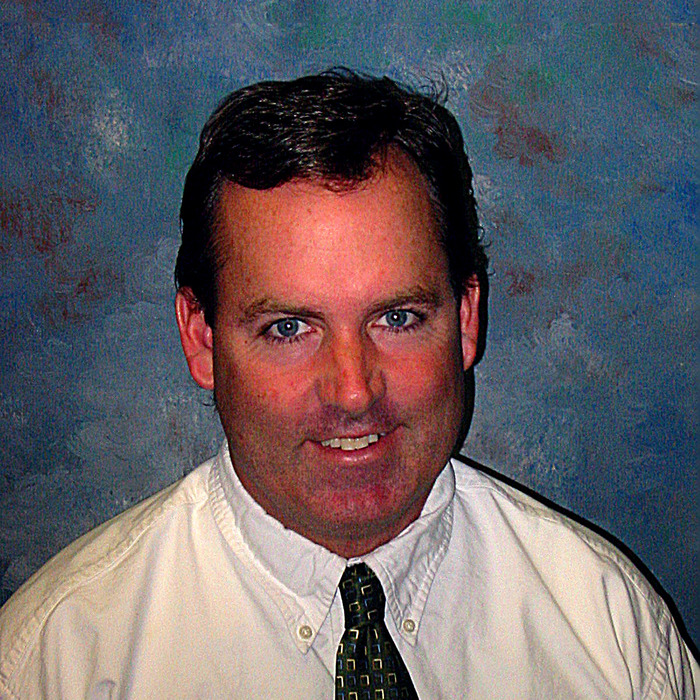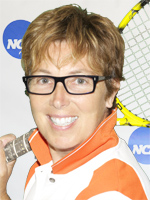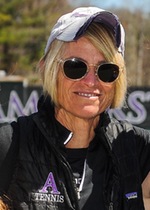Did you think that we’d forgotten about our Competitiveness Series amidst the excitement of NCAAs? Well, we didn’t. So far in our series The Analyst dropped her fiery first article, we had a blogger roundtable, a very factual discussion of competitiveness in recent history, and asked a whole bunch of amazing coaches for their perspectives on this year of D3 women’s tennis. Today we turn our attention to the potential D3 players and parents in the room. I know you are out there, and thanks for reading! We had our expert panel of coaches give their thoughts on recruiting and what they look for in their next star players, and no surprise, it goes so much further than your number of stars or your TRN. This seems like an appropriate place to give another shout out to those players who may not have been the highest ranked recruits but had that growth mindset in college and kicked butt anyways.
Let’s reintroduce our awesome panel of coaches:
Coach Jackie Bagwell – Amherst – Coach Bagwell is in her 28th season as head coach. She has coached NCAA Champion teams and taken Amherst to the NCAA quarterfinals in 21 of the last 22 seasons.
Coach Kathy Campbell – Vassar – Coach Campbell has been at Vassar since at least 1988. Since then, her teams have been ranked in the top 15 in the Northeast and nationally ranked for over 20 years. In her tenure, the Brewers have qualified for NCAAs 10 times by winning the Liberty League title
Coach Mike Fried – Wesleyan – Coach Fried is in his 7th season as head coach of men’s and women’s programs. He has guided the Cardinals to the national scene, and as we have seen they are consistently ranked in the top 10. Wesleyan just won the NESCAC tournament.
Coach Kate Bayard – Tufts – Coach Bayard is in her 14th year as head coach. Under her guidance, Tuft’s women’s tennis has made 12 NCAA appearances (soon to be 13) and has consistently been in the Top 10, including a highest position of #3 in 2017.
Coach Jon Carlson – Gustavus Adolphus College – Coach Carlson is in his 29th season as head coach. Under his guidance GAC has won the MIAC title 24 times. Back in 1990, Coach Carlson led his squad to the NCAA National Title.
Coach Amy Bryant – Emory – Coach Bryant – Coach Bryant is in her 19th season as head coach, with 18 appearances in the NCAA national quarterfinals and 12 appearances in the finals. Her team has won the NCAA championship 6 times.
Coach Erin Ness – Washington and Lee – Coach Ness is in her 7th year as head women’s tennis coach. She has won the ODAC conference all 7 years of coaching and has made at least the NCAA Second round every year.
Coach Art Canizares – Mary Washington – currently in his 1st year as the interim head coach at Mary Washington, Coach Canizares had been assistant coach for 13 years before that. During his tenure the eagles have made the NCAA Tournament every year by capturing the CAC Championship.
Coach Conchie Shackelford – Sewanee – Coach Shackelford is in her 33rd season as head coach. She has won 12 SAA conference championships with 25 NCAA tournament appearances. She has produced 9 top-10 year end rankings and 19 top-15 year end rankings.
Coach Billy Porter – Southwestern—Coach Porter is in his 6th season as head coach of men’s and women’s programs. He led the women’s program to it’s highest ever ranking of #23 nationally in 2018, only to beat it this year with a program high of #21 nationally.
Coach Mandy Gamble – Caltech – Coach Gamble is in her 17th season as head coach for Caltech. This year the team has seen an unprecendented rise in rankings, achieving it’s highest ever ranking of #18 nationally.
Now to our roundtable–
Recruiting was probably the most cited factor by the coaches in making a competitive team. It’s this long process that starts as early as junior year of high school, where the end goal is finding someone who agrees that you would be a good “fit” for their program. Where do you even start? What do you look for when you have 1000 players in the country who could potentially be a good fit?

Coach Canizares (Mary Washington): I think each program has it’s basic criteria for the type of player it wants. While we all want the elite players, most of us know that one of the great selling points of D3 tennis is going to a place where winning right away comes second to learning how to play the right way even if it takes a little more time. At our program at UMW, we have players of all different playing styles and abilities. We have a basic style of play we prefer, but we know that style has to be adapted to the strengths and characteristics of each individual player. It’s no big secret that over the years, our best players aren’t necessarily the highest ranked coming out of juniors but are the ones that have a strong all-court games, want to put in the work that it takes to get better, and are most open to coaching and adapting to situation that each match brings. We also put a big emphasis on how recruits get along with our current players. Our players often play better than their UTR’s because they are more interested in helping the team to succeed than looking for individual glory. Some of the higher-ranked schools can select players just by the numbers without really meeting them in person, but we have always made it a priority to get to know our recruits as well as possible regardless of their rankings and UTR’s in order to have a better idea of how they will contribute during their college careers.

Coach Carlson (GAC): The first thing I look for is whether they love tennis and love to compete. To try to bring joy back (or, believe it or not, introduce for the first time) into tennis and competing is a much bigger project, and more important, than raising someone’s level of play. Then I look at their athleticism. Are they a good athlete? Did they play and compete in other sports? Multi-sport athletes are better competitors (there are exceptions) and have more confidence in trying new things. Learning and doing new things for them is like a fun puzzle, rather than something to be feared.
How do you gauge a “competitive” or “good” recruit/recruiting class? Rankings (TRN, UTR, national, etc)?

Coach Ness (W&L): In terms of rankings, I think the most competitive recruiting classes consist of UTR high 8’s and 9’s. However, each program is looking for the right culture fit as well. Some schools rely more on development because they may not be able to get those top ranked kids. The CMS team who won the NCAA Championship this past year did not have the highest ranked players on paper, but they competed harder and were more disciplined than any other team in the tournament.

Coach Bayard (Tufts): I don’t like to categorize my recruiting class based on the #s. While I use UTR/TRN stars to get an initial idea, I’m much more focused on specific results, potential, coachability, growth, and work ethic. That said, if people who are in HS now are pretty similar in level to those who are currently impact players on my team, I think it’s possible they could potentially be part of a competitive recruiting class. I try not to get too caught up in the numbers or the stars since my two most accomplished players in all my years of coaching were totally undercover.

Coach Fried (Wesleyan): It’s tough to say exactly what constitutes a competitive recruiting class, as it’s all relative to the competition! That said, in recent years, the rankings of top DIII recruits continue to rise pretty rapidly. It’s no longer unusual to see high 4-star, UTR 9.0/9.5+ (or higher) recruits heading to top DIII programs. Clearly, rankings (and recruiting in general) are only part of the picture though. It’s particularly cool to see those somewhat lesser ranked (and often somewhat more overlooked) recruits who are completely committed to growing their games and helping their teams jump into the mix of top players by their sophomore/junior years.
Can you tell right away when a player arrives as a freshman whether or not they’ll be one of your big contributors?

Coach Porter (Southwestern): It’s always unpredictable as college changes them from being a child to being an adult faster than most realize and some want. Every program is different but one of the biggest challenges we face eventhough we recruit directly about it is getting junior tennis players that have primarily played for themselves to buying in to the college tennis culture immediately. Talent is nice to have but for us the key to their success is the atmosphere and environment they are put it to excel the most. If they give themselves to the program fully right away they typically start out as a contributor compared to those that only partially give themselves as they tend to struggle with the individualistic vs team approach as the first denominator with other challenges of listening or being coachable slowing down their contribution.

Coach Gamble (Caltech): It depends on where your program is in its development cycle as to what level player will make an impact. It’s harder for programs with top 10 rankings to maintain their ranking and a couple of low 4 stars might not make a difference but those same recruits could be game-changers for programs ranked in the 15-40 range, especially if they have some solid 3 stars. The UTR algorithm changes from time to time and I see it fluctuate between juniors and college players. On the women’s side, generally, recruits with UTR’s around 8.75 and above are pretty competitive. No one can tell 100% how competitive a recruit will be when they arrive on campus. It is usually after the ITA tournament where I have a better read on that. After I’ve worked with a player for a couple of weeks and seen them compete I get a sense of how they respond best and if they are a team player and how important tennis is in their college experience. Another important factor is the connection between the coach and recruit. That has to be there for a successful student-coach relationship.
Looking back on the players that did end up being big contributors for your team, what kinds of characteristics did these women have?

Coach Bryant (Emory): On our team, the most important characteristics for success are: selflessness, having an attitude with gratitude and having a learning, growth mindset. In addition she controls the 2 things that are within her control – her effort and attitude. Those are the players I’ve had the most success coaching!

Coach Shackelford (Sewanee): I believe the most important characteristic that a coach is looking for is to find someone who still loves the sport and is willing to put in the work and make the necessary sacrifices to continue to improve in college. I’ve always found that certain players have an inner competitiveness and toughness that allows them to succeed in the college game. One of the most difficult things to teach is that ability to respond to adversity under pressure. College life is full of many choices and demands. A successful student athlete needs an inner drive that balances their priorities in a way that makes them successful across the spectrum. I often say, “How you do one thing, is how you will do all things.” Traits like discipline, focus, enthusiasm, openness to new ideas, determination, and resiliency are all factors in predicting success in college tennis and beyond the gates of the university.
And finally, a nugget of wisdom from the legendary Jackie Bagwell.

Coach Bagwell (Amherst): Who said it? “Rankings are what other people think of you, results are what you think of yourself. I would much rather have lower ranked players who are obsessed and looking to improve than higher ranked player’s who’s motivation and best tennis is behind then.
Now that we’ve gotten a glimpse into the minds of some of D3’s most successful coaches, it’s pretty easy to see that personal characteristics are just as important as the numbers, probably even more important. Thank you so so much to the coaches who let me pick their brains. We are so lucky to have such supportive coaches in D3 who promote both tennis and personal development. Just one of the many reasons why D3 is the way to go. #WhyD3.
Inspired by Coach Bryant’s answer, I’m going to end with unsolicited advice from myself, a large child who has been passing off as a functioning adult. Growth mindset vs. fixed mindset. Look it up. Bring it up at any job/grad school interview, and make sure that they know you have a growth mindset. They will love it, and therefore you. You can thank me later.
Now that we’re ramping up our NCAA finals coverage, you can be sure you’ll hear more from me and the rest of the Blog team soon!
ASW